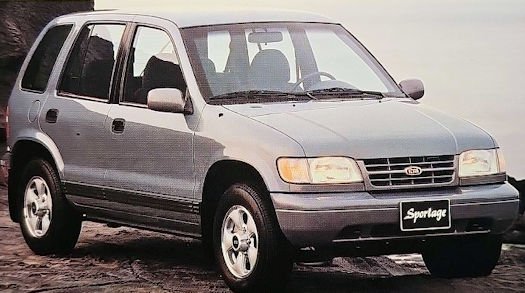Kia Sportage First generation
 |
|
| Production | July 1993 to 2004 |
|---|---|
| Assembly | South Korea: Hwaseong, Gyeonggi Germany: Osnabrück Russia: Avtotor Plant, Kaliningrad |
| Body style | 3-door convertible 5-door wagon |
| Layout | Front-engine, rear-wheel drive Front-engine, four-wheel drive |
| Engine | 2.0 L FE I4 (gasoline) 2.0 L FE DOHC I4 (gasoline) 2.0 L RF I4 (diesel) |
| Transmission | 4-speed automatic 5-speed manual |
| Lenght | 4,24 m. |
| Width | 1,73 m. |
| Height | 1,65 m. |
| Kerb weight | 1.494 kg. |
Sportage was sold in either a five-door wagon or a two-door soft-top convertible. Kia initially developed the wagon in standard length form, but in circa 1996, the company released an extended length version. This stretched model—mainly sold in Asian markets under the name "Sportage Grand"—featured a 305 mm (12.0 in) longer body utilising the same wheelbase, an increase in luggage capacity from 1,570 to 2,220 liters (55.4 to 78.4 cu ft), and the relocation of the spare wheel from the tailgate to underneath the floor.
Kia offered three Mazda-sourced engines in the Sportage, beginning with the 2.0-liter FE DOHC inline-four gasoline unit producing 95 kW (128 hp) and the 2.0-liter RF inline-four diesel rated at 61 kW (82 hp). Diesel-engined models were mostly restricted to European markets, as was the more basic single overhead camshaft (SOHC) version of the 2.0-liter FE gasoline inline-four. Delivering 87 kW (117 hp), this gasoline engine was available from 2000 onwards. In North America, the 2.0-liter FE DOHC engine produced 130 hp (97 kW) and had optional four-wheel drive. The 1998 model year Kia Sportage was the world's first production vehicle to be equipped with a knee airbag.
Performance:2.0L 16V
- Max power kW 94 (bhp DIN 128) at 5.300 rpm.
- Max torque Nm 175 at 4.700 rpm.
- Power/litre 64,1 bhp
- Power/- weight 11,7 kg/bhp.
- Top speed 166 km/h
- 0-100 km/h 14,7 sec
- Fuel consumption DIN (at 120 km/h) 11,9 litres/100 km.
This first generation model (1993–2002) sold in low numbers even domestically in South Korea, and post-Hyundai takeover models (1997–2002) were recalled twice for rear wheels dismounting while driving. The first generation Sportage was discontinued in South Korea in 2002, and in North America after the 2002 model year. By 2003, most international markets had discontinued the Sportage range, although it did remain on sale in some developing countries until its second generation replacement arrived in 2004.
The Kia Sportage scored the lowest possible result in the Australian ANCAP crashtests – one star out of five. As well as a failure of the seatbelts, the vehicle structure collapsed.
Technical
-
Kia Sportage Kia Sportage 1st gen (1993-2004)
DIMENSIONS AND WEIGHT:
lenght 4,24 m.
width 1,73 m.
height 1,65 m.
Kerb weight 1.494 kg.
Tank capacity litres 60.ENGINE: 2.0L
cylinders 4/OHC
1998 cc
Firing order 1-3-4-2
Compression ratio 8,6:1
Fuel system Make Mazda Type EGI
Air metering Type Mass
Fuel system pressure 3,5 bar
Oil pressure 3,4-4,4 bar @ 3000rpm
Radiator cap 0,75-1,05bar
Thermostat opens 86,5°CENGINE: 2.0L 16V
4 cylinders
front transverse
1.998 cc.
4 valves per cylinder.
Compression ratio 9,2:1.
Bore/stroke 86,0 x 86,0 mm.
TRANSMISSION DRIVE LINE:
four-wheel drive.
5 speed manual.STEERING:
Steering power assisted.
Turning circle 11,20 mBRAKES:
front ventilated discs
Rear drums.SUSPENSION:
front McPherson independent wheels, hydraulic dampers, anti-roll bar.
Rear live axle, hydraulic dampers, anti-roll bar.WHEELS TYRES:
Tyres: 205/75 R 15.© Motor car History
Service
-
Kia Sportage Kia Sportage 1st gen Maintenance and Service Guide (1993-2004)
Drive belt tension -7,9 mm
Manual gearbox oil grade 75W/90 SAE
Manual gearbox oil 1,25 litres
Automatic transmission fluid Type Dexron IIE
Automatic transmission fluid 6,8 litres
Differential oil grade - front and rear 80W/90 SAE
Differential oil front and rear 1,2 litres
Cooling system 7,0 litres
Brake fluid Type DOT 3/4
Brake fluid 0,8 litres
Power steering fluid Type PSF-II
Power steering fluid 0,7 litres2.0L petrol engine
Spark plugs Electrode gap 0.8-1.0mm
Spark plugs Original equipment NGK Type BKR5E
Valve clearance -INLET 0,30mm check hot
Valve clearance -EXHAUST 0,30mm check hot
Engine oil grade - cold climate 5W/30SAE
Engine oil grade - normal/moderate climate 10W/30SAE
Engine oil grade - hot climate 20W/50 SAE
Engine oil change with filter 4,2 litres
© Motor car History
